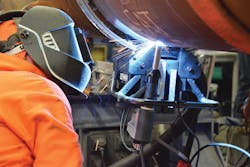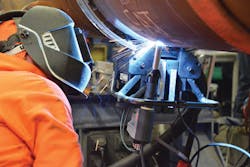Alliance targets welding gains at Technip spoolbases
Technip and Serimax have announced a new strategic partnership in pipeline welding which will lead to Serimax, a subsidiary of Vallourec, deploying its welding technologies at Technip spoolbases and offshore on Technip’s S-lay vessels.
Under the agreement, the two companies will also work on solutions to help advance more pipelay projects at a time of continuing capital constraints; and they will invest in joint R&D programs and new types of reel-lay welding procedures to address the technical challenges associated, for instance, with pipes made from exotic materials. The ultimate goals are to achieve improved productivity and operational performance.
Terms of the partnership include an exclusive co-operation in reel-lay pipeline welding. Technip will take a minority interest in Serimax, although the latter will remain an independent technology and service provider, continuing to work for its existing clients in offshore, onshore pipeline and fabrication markets.
According to Vallourec’s Pipe Project Division Managing Director Dominique Richardot, the impetus for the alliance came from Technip’s desire to harmonize welding solutions across its spoolbases in Mobile, Alabama, USA; Evanton in Scotland, UK; Orkanger in Norway; and Dande in Angola.
“Instead of doing this in-house, they decided to work with a dedicated supplier. They chose Serimax partly because of the technological content in our offer - one of Technip’s targets is to reduce costs through innovation. Another reason was Serimax’s geographical presence, and the fact that we can also deploy teams to assists their personnel,” Richardot said.
Cyril Tigien, Technip’s VP Welding& NDT Product Line, said: “Part of our strategy is to invest in technology as an enabler to optimize cost and to make our projects more effective. Working with Serimax we can develop better, integrated and fit-for-purpose solutions to improve productivity and delivery times, while harmonizing welding procedures at our spoolbases will give us greater operational strength, repeatability and reliability, also removing the need to keep retraining staff for each new project.”
Richardot added: “Integration means no interference on either side, but rather a clear interface between two companies working on ideas for reducing overall costs…and as we have committed to co-operate on Technip’s spoolbases from now on exclusively it means we can discuss requirements for individual projects with them much earlier thereby ensuring greater added value overall for their clients.” Serimax will continue to work offshore on other clients’ J-lay and S-lay vessels.
Technip and Serimax have co-operated closely at Evanton over the past 15 years, so implementation of the principles of the agreement will start there, followed by others spoolbases. The two companies hope to have the new model in place in all the spoolbases by the end of this year.
As for technical solutions, Technip is looking for the alliance to deliver continuous improvements in welding production rates and a decrease in the volume of reject welds, Tigien said, including for pipes constructed from exotic materials that are more challenging to weld. “If you take corrosion-resistant alloys [CRA], welding speeds are too slow, typically 500 m [1,640 ft] for 35-40 welds over a 12-hour period. To improve this, we have to work on new technologies to weld faster and more efficiently.” Over the past 20 years Serimax has continuously upgraded its digital multi-process bug and band welding system Saturnax. The latest version, Saturnax S09, can be configured for welding a wide range of CRA pipes installed via the J-lay or S-lay method.
Another of Technip’s R&D targets is to improve weldability of high-strength steels such as X80 pipe, which may involve devising solutions to decrease the weld thickness. The company also plans to work with Serimax on inspection methodologies to ensure proper fit-ups, Tigien said. “At our spoolbases or at the offshore construction site, we receive pipes which are provided either by the customer or Technip. We will typically employ four to six welding stations to weld single pipe 12 m in length to construct pipe stalk in excess of 1,000 m ready to be reeled. At the same time our technicians or NDT subcontractors are inspecting the welds using NDT automated ultrasonic or digital radiography techniques and simultaneously we are applying field joint coating. We are looking to optimize the cycle time, to be more cost-effective, and to achieve lower weld rejection rates.
“As the challenges of offshore pipelay become greater - deeper water, CRA - we cannot just qualify the welding procedures for the job. This process must be prepared months in advance in parallel with the engineering and design in order to optimize the solution, and this is something the partnership will be working on based on lessons learned from previous jobs.”

